 |
 |
|
 |
 |
Soviet Union: Zenit: 1952-2005:
Zenit
Zenits first PP SLR was introduced in 1952. Zenit was among the very first, but was never a leader by technology. They followed international trends, and although often being some years behind, they had some worlds first, like the motor driven Zenit
5. They delivered very solid cameras that sold in high numbers, mostly on the home market. But they they were falling behind as the Japanese producers introduced new technology like autofocus. And as the new digital cameras took over, the company could not
follow and ended production in 2005. The Zenit brand is presented through most of its first models from the 50's and 60's, more sporadic from the 70's till the end.
1952: Zenit:
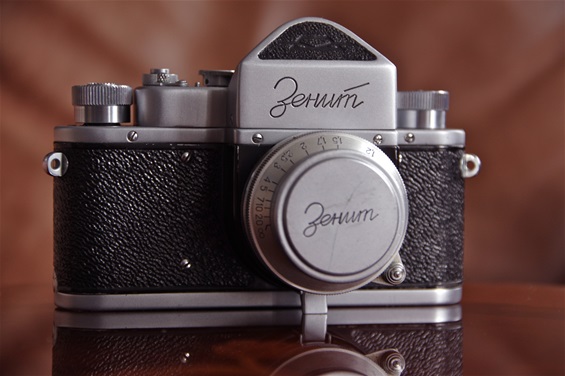 Built on the chassis of the Zorki rangefindre camera, and added a penta prism on top, the KMZ factory in Kraznogorsk outside Moscow was able to show this Zenit in 1952. The Zorki was a copy of the Leica II, so this very neat and well working Zenit was the closest one ever got to a pioneer Leica PP SLR. Produced from 1952 till 1956, 39.019 copies sold. A beautiful camera that works well. Size: 134x91x50mm. Weight: 528 g. Sn. 5420961.
Built on the chassis of the Zorki rangefindre camera, and added a penta prism on top, the KMZ factory in Kraznogorsk outside Moscow was able to show this Zenit in 1952. The Zorki was a copy of the Leica II, so this very neat and well working Zenit was the closest one ever got to a pioneer Leica PP SLR. Produced from 1952 till 1956, 39.019 copies sold. A beautiful camera that works well. Size: 134x91x50mm. Weight: 528 g. Sn. 5420961.
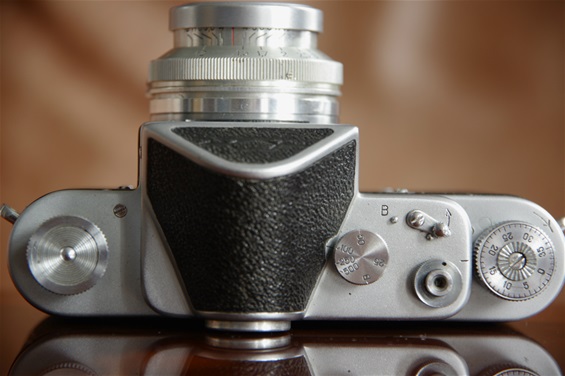 Older cameras sometimes had a top deck, as on most range finder cameras. Winder and counter to the right, rewinder to the left and shutter release button plus shutter speed and rewind release handle on upper deck. A very neat camera, and the brightest viewer you can think of! Shutter times from 1/25 (later 1/30) to 1/500. The handle in front of the shutter release button must be set to B to rewind the film.
Older cameras sometimes had a top deck, as on most range finder cameras. Winder and counter to the right, rewinder to the left and shutter release button plus shutter speed and rewind release handle on upper deck. A very neat camera, and the brightest viewer you can think of! Shutter times from 1/25 (later 1/30) to 1/500. The handle in front of the shutter release button must be set to B to rewind the film.
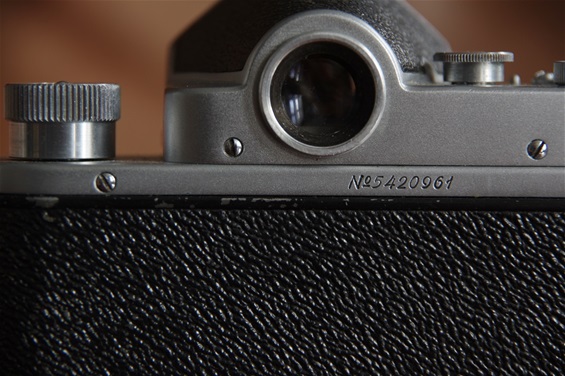 The serial number starts with 54, so it is produced in 1954. There were only 200 produced in 1952, 1243 in 1953, and the major bulk in '54 and '55. The different variants showed only small differences. The most significant was the logo itself, the very first ones had framed square letters. That logo came back from time to time, but most carried the logo like this one, handwritten style. Other details were sn. in standing types or in cursive, painted or vulcanized short side of the lens mount section, lifted or engraved logo on the prism house front. And, shown here, one or two screws on the upper back wall.
The serial number starts with 54, so it is produced in 1954. There were only 200 produced in 1952, 1243 in 1953, and the major bulk in '54 and '55. The different variants showed only small differences. The most significant was the logo itself, the very first ones had framed square letters. That logo came back from time to time, but most carried the logo like this one, handwritten style. Other details were sn. in standing types or in cursive, painted or vulcanized short side of the lens mount section, lifted or engraved logo on the prism house front. And, shown here, one or two screws on the upper back wall.
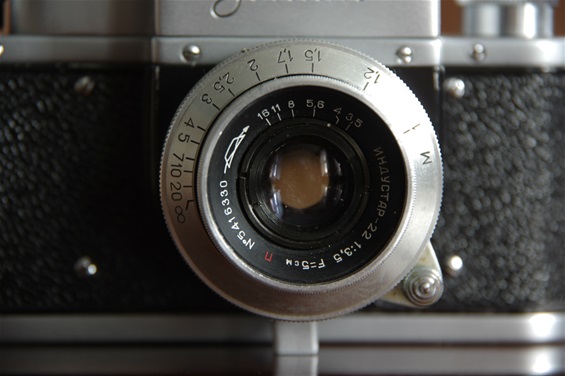 The well known standard lens, the Industar 50/3,5. The first Zenit models featured a M39 mount. Sn. 5416330.
The well known standard lens, the Industar 50/3,5. The first Zenit models featured a M39 mount. Sn. 5416330.
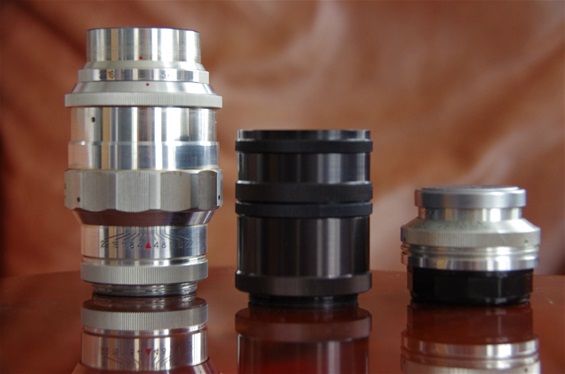 Jupiter 11 135/4 tele, extension tubes + Industar 22 50/3,5.
Jupiter 11 135/4 tele, extension tubes + Industar 22 50/3,5.
1955: Zenit C (S):
Zenit S replaced the Zenit in 1955 and was produced till 1962 in a total of 232.949 pieces.
The C (S) stands for Syncronized, meaning via the flash socket in the front. A reader has informed me that what looks like a long shuttertime scale is rather
numbers for syncronizing the flash, from 0 to 25 ms. The rewind release handle on the top deck was replaced by a dial around the shutter release button.
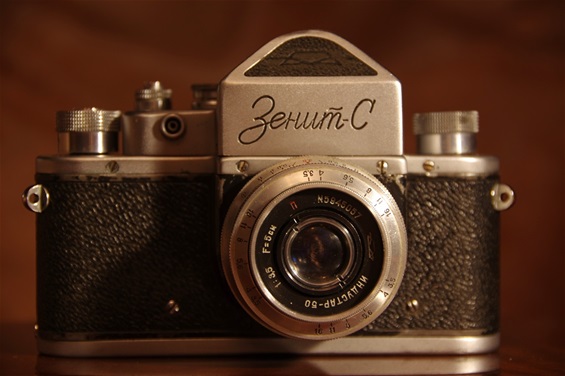 The Zenit S of 1955. The only visible change as seen from the front is the flash socket under the shutter release button.
Sn. 59910675. Same measures as the Zenit 1. Weight: 535 grams.
The Zenit S of 1955. The only visible change as seen from the front is the flash socket under the shutter release button.
Sn. 59910675. Same measures as the Zenit 1. Weight: 535 grams.
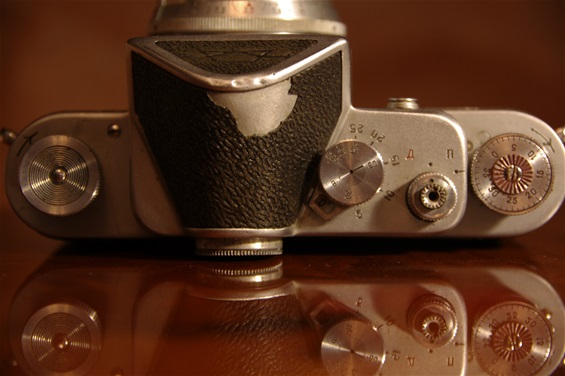 A torn leatherette and dents on the prism top. More interesting is the introduction of a scale from 0 to 25 ms for flash syncronization.
A torn leatherette and dents on the prism top. More interesting is the introduction of a scale from 0 to 25 ms for flash syncronization.
Lens
A standard Industar 50/3,5 lens.
Case
Those were the days of handcrafted leather cases, even with make and model engraved!
1959: Zenit 3:
With the third model, Zenit introduced a rather modern camera. A smooth winder arm, a new prism house, no extra top deck and a self timer were features that could match the Japanese. But it proved too expensive to produce and was terminated in 1962.
Introduced in 1959, but produced from 1960 till 1962. Total of 81.776 bodies.
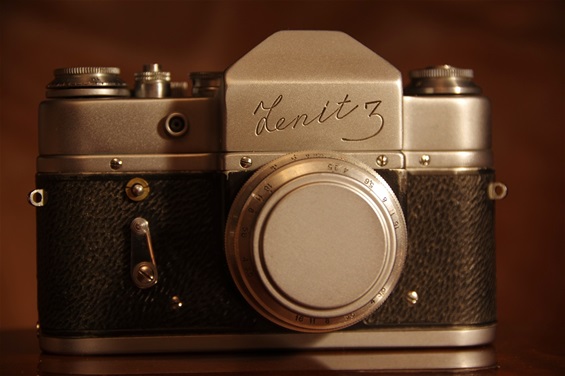 The Zenit 3 was Zenits third model, featuring a new construction. The top deck was incorporated into the house, giving a more modern shape. There was a self timer in the front and a new prism house as well. The flash socket from Zenit S was kept. This model was even smaller than the previous ones: 133x89x 47 mm. But a bit heavier: 592 grams.
The Zenit 3 was Zenits third model, featuring a new construction. The top deck was incorporated into the house, giving a more modern shape. There was a self timer in the front and a new prism house as well. The flash socket from Zenit S was kept. This model was even smaller than the previous ones: 133x89x 47 mm. But a bit heavier: 592 grams.
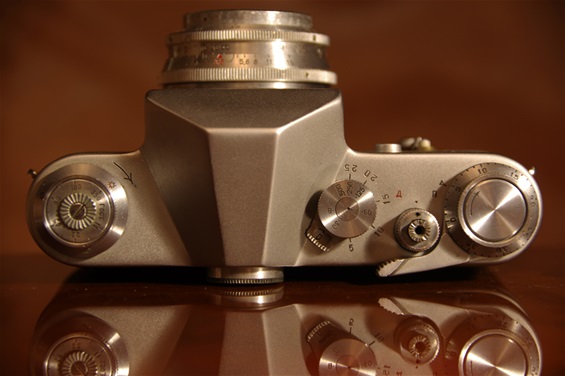 In addition to the new and modern top plate, Zenit also introduced a new winder arm. It has a pleasant feeling, not too hard and not too long movement. And the shutter still works well, with a nice sound. This model may represent the highest quality that Zenit ever built.
In addition to the new and modern top plate, Zenit also introduced a new winder arm. It has a pleasant feeling, not too hard and not too long movement. And the shutter still works well, with a nice sound. This model may represent the highest quality that Zenit ever built.
Their kit lens, an Industar 50/3,5
An almost unused case with model name stamped into it.
Produced in 1962, the last year for this model.
1961: Krystall:
In 1961 the Krystall followed the Zenit 3, and like its elder brother it was produced for only a short time. While the Zenit 3 was stopped because it was too expensive to produce, the Krystall was taken out of production after only one year because
of the not so popular hammer paint. No other camera has ever had this surface. Today, it is regarded as a bold design, and popular as a collectors item. 65.433 units were produced until mid 1962.
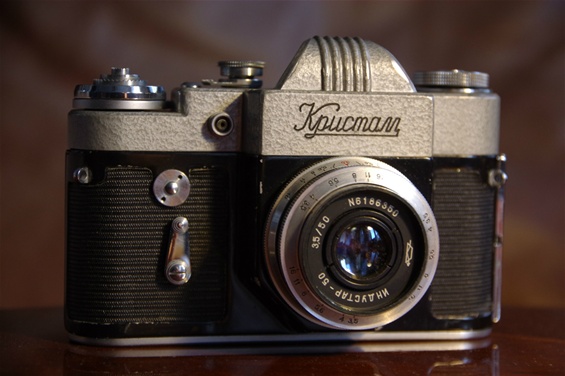 Here is a rather rare Krystall, an unmistakeable Zenit, although no such logo was ever found on it. The top deck was back, so the more modern design of the Zenit 3 was abandoned. The hammer paint and the stripes over the prism were bold design moves, but it was never catching on. The Krystall was replaced by the almost identical 3 M in '62.
Measures as 3M. Weight 587g. Sn. 61025312.
Here is a rather rare Krystall, an unmistakeable Zenit, although no such logo was ever found on it. The top deck was back, so the more modern design of the Zenit 3 was abandoned. The hammer paint and the stripes over the prism were bold design moves, but it was never catching on. The Krystall was replaced by the almost identical 3 M in '62.
Measures as 3M. Weight 587g. Sn. 61025312.
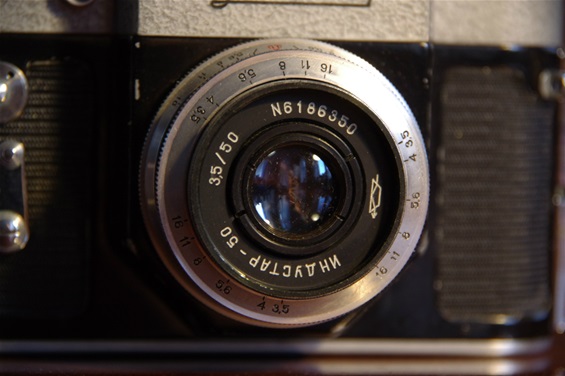 The Industar 50/3,5 standard lens. Sn. 186350.
The Industar 50/3,5 standard lens. Sn. 186350.
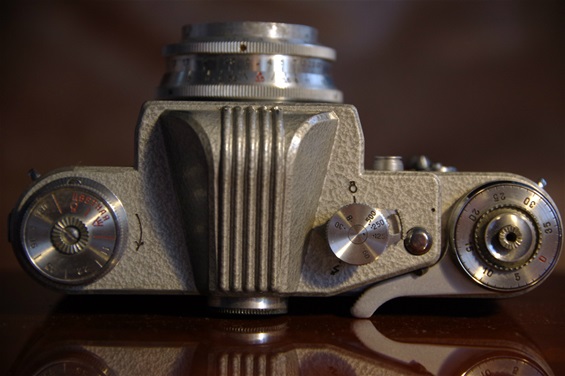 A new winder arm replaced the one from Zenit 3, and the top deck from the first models was back. Aside from the hammer paint and the five elevated stripes, this is exactly like the later 3M.
A new winder arm replaced the one from Zenit 3, and the top deck from the first models was back. Aside from the hammer paint and the five elevated stripes, this is exactly like the later 3M.
1962: 3 M:
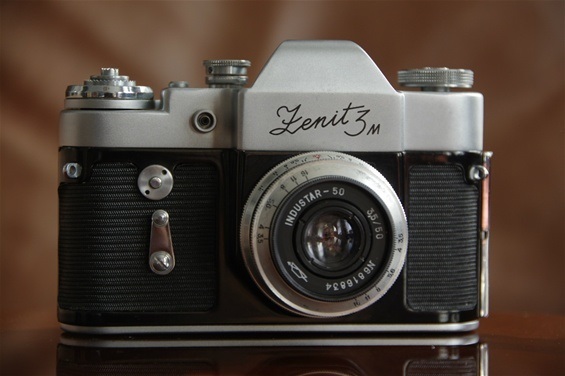 Zenit 3 M was number five in the Zenit line, following the Zenit, then Zenit C (S), (232.949 copies) 1955-1961, Zenit 3, 1960-1962 (87.776 copies) and Krystall, 1961-1962 (65.433 copies). Zenit 3 M was produced from 1962 till 1970 in 781.678 units.
Size: 137x89x49mm. Weight: 621 grams. Sn. 68004868
Zenit 3 M was number five in the Zenit line, following the Zenit, then Zenit C (S), (232.949 copies) 1955-1961, Zenit 3, 1960-1962 (87.776 copies) and Krystall, 1961-1962 (65.433 copies). Zenit 3 M was produced from 1962 till 1970 in 781.678 units.
Size: 137x89x49mm. Weight: 621 grams. Sn. 68004868
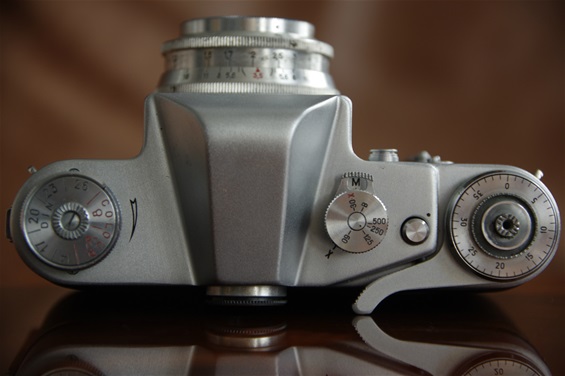 Top deck, as on Zenit 1. Simple and elegant layout.
Top deck, as on Zenit 1. Simple and elegant layout.
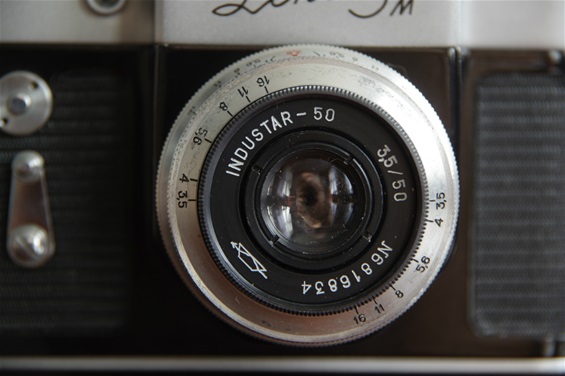 Standard Industar 50/3,5. M42 mount. Sn. 6816834.
Standard Industar 50/3,5. M42 mount. Sn. 6816834.
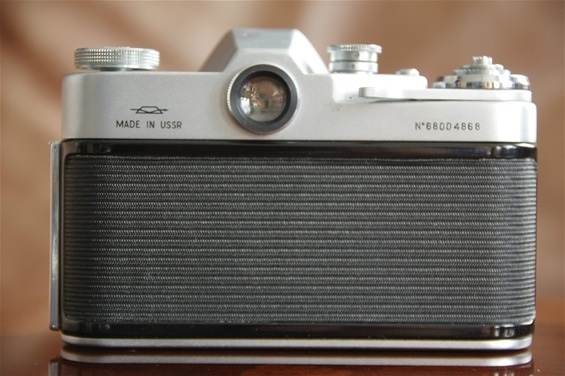 Sn. 68004868. First two digits shows year of production. So, this one is produced in 1968.
Sn. 68004868. First two digits shows year of production. So, this one is produced in 1968.
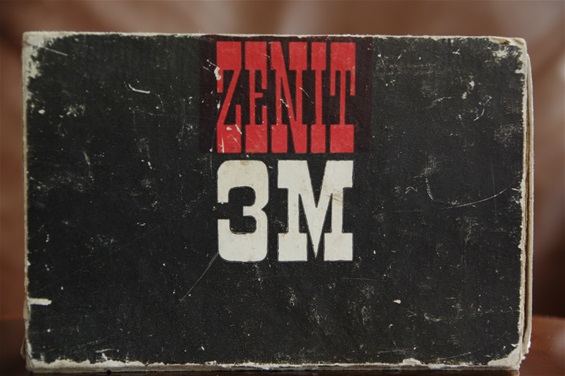 A somewhat worn box with all original papers inside.
A somewhat worn box with all original papers inside.
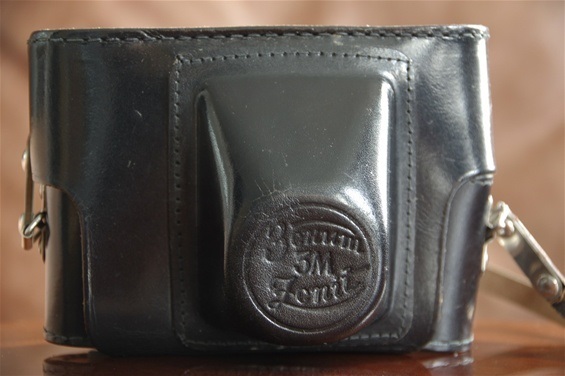 The case, however, is almost like new.
The case, however, is almost like new.
1964: Zenit 5:
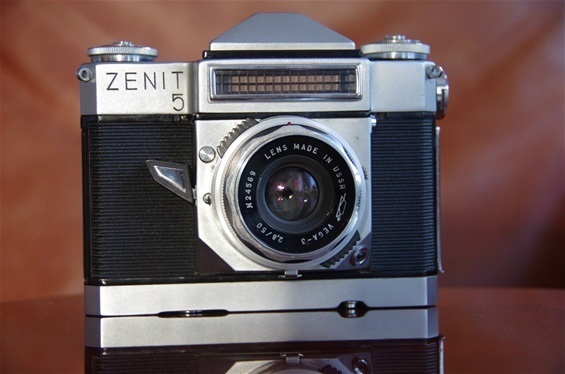 The Zenit 5 was a copy of the model 4 (not shown), but with one major difference: it introduced a built in motor as the first PP SLR to do so. The batteries were built into the bottom of the camera, thus the extra height. A charger was to be plugged into a hole i the base plate to charge the batteries, and a on/off switch determined motor/manual mode. Size: 140x110x49 mm. (House)
Weight with fixed lens: 1367 grams!
Sn. 6602564.
The Zenit 5 was a copy of the model 4 (not shown), but with one major difference: it introduced a built in motor as the first PP SLR to do so. The batteries were built into the bottom of the camera, thus the extra height. A charger was to be plugged into a hole i the base plate to charge the batteries, and a on/off switch determined motor/manual mode. Size: 140x110x49 mm. (House)
Weight with fixed lens: 1367 grams!
Sn. 6602564.
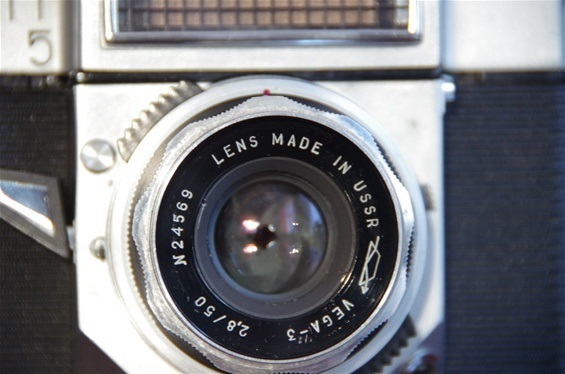 A Vega-3 lens, 50/2,8. The Zenit 4 introduced a West-German style leaf shutter behind a fixed lens. This was to follow on the Zenit 6 as well. Although this shutter was locally popular in West-Germany, it had no future and died with the West-German brands.
A Vega-3 lens, 50/2,8. The Zenit 4 introduced a West-German style leaf shutter behind a fixed lens. This was to follow on the Zenit 6 as well. Although this shutter was locally popular in West-Germany, it had no future and died with the West-German brands.
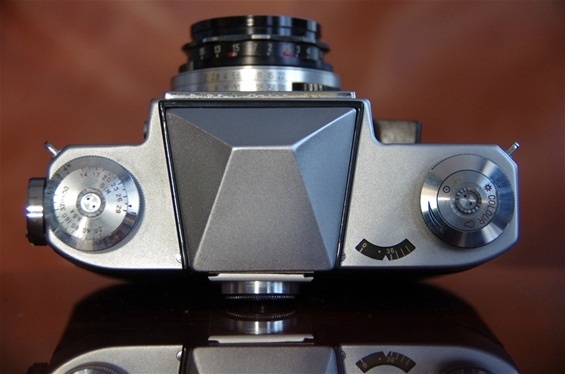 A very clean layout, as shutter times are on the lens and shutter release button on winder knob.
A very clean layout, as shutter times are on the lens and shutter release button on winder knob.
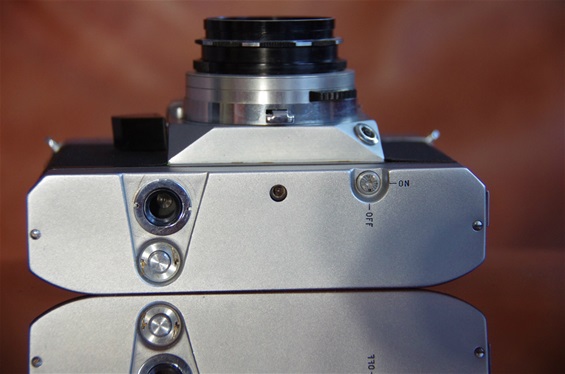 The base plate with hole for charger.
The base plate with hole for charger.
1966: Zenit E:
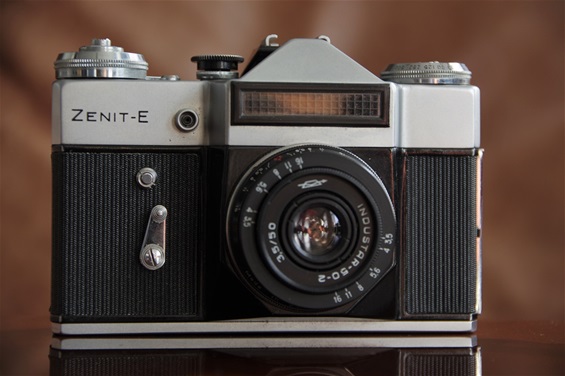 The Zenit E of 1966 was produced in a number of more than 3 million till 1986, when production was stopped.
Zenit produced many models through the years, some by Belomo in Ukraina.
The last model, the KM Plus, was produced till 2005, in 15.097 units.
This E model weighs 702 gr. Size: 137x89x49 mm. M42 screw mount. Sn. 72004734.
The Zenit E of 1966 was produced in a number of more than 3 million till 1986, when production was stopped.
Zenit produced many models through the years, some by Belomo in Ukraina.
The last model, the KM Plus, was produced till 2005, in 15.097 units.
This E model weighs 702 gr. Size: 137x89x49 mm. M42 screw mount. Sn. 72004734.
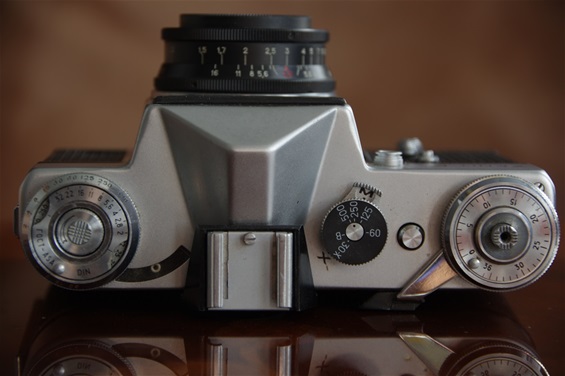 A metering system much like the west-germans around 1960. Not coupled, so one would chose aperture or shutter time and then read the suggested combination from the circle meeting an arrow. A rather old fashion system, considering that it was sold up till 1986!
A metering system much like the west-germans around 1960. Not coupled, so one would chose aperture or shutter time and then read the suggested combination from the circle meeting an arrow. A rather old fashion system, considering that it was sold up till 1986!
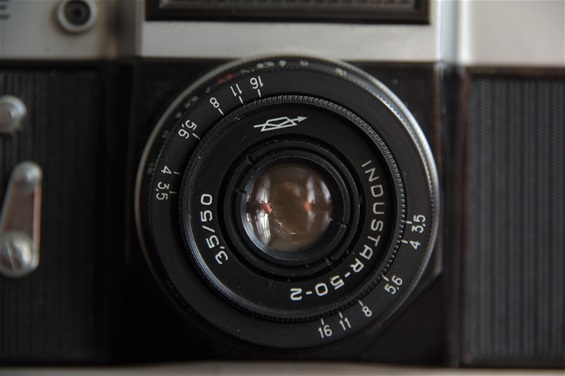 Another Industar 50/3,5. Slow, but optically good.
Another Industar 50/3,5. Slow, but optically good.
1976: Zenit TTL
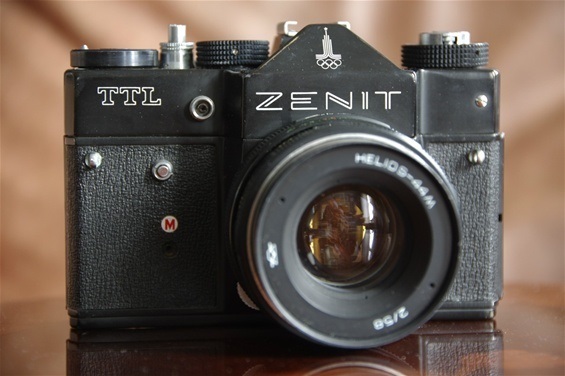 The TTL was the first Zenit to feature a TTL metering, more than 10 years after Topcon and Pentax. Many variants were built, summing up to more than 1,6 million cameras.
Ended in 1985.
The TTL was the first Zenit to feature a TTL metering, more than 10 years after Topcon and Pentax. Many variants were built, summing up to more than 1,6 million cameras.
Ended in 1985.
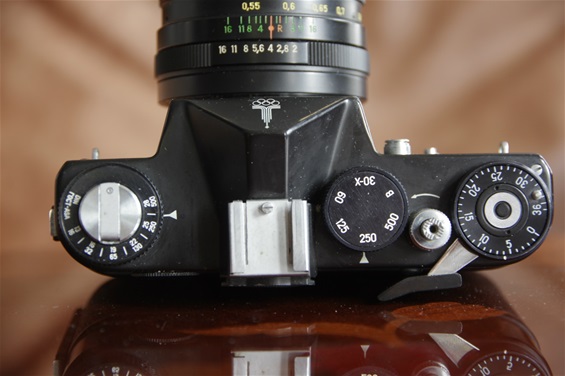 Plain, traditional layout. Shutter times from 1/30 to 1/500.
Plain, traditional layout. Shutter times from 1/30 to 1/500.
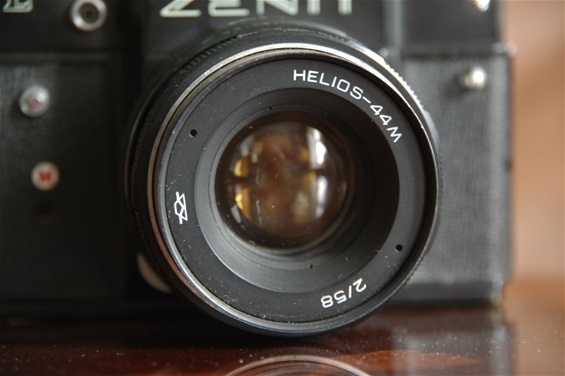 Helios 44 58/2 has a good reputation even today.
Helios 44 58/2 has a good reputation even today.
1998: Zenit 312 m:
During the 90s it became obvious that Zenit could not compete with the more modern Japanese brands. The lack of autofocus, very limited shutter times and, most important, lower degree og quality left the brand with hardly anything but price as a weapon.
Zenit introduced a new series, the '12 series, consisting of 212, 312 and 412 models, all based on the 122 model from 1990 but with a quite new design. But their sales were small compared to the 122, only some hundred thousand compared to the 1,9 million 122s.
312 model alone sold 71.834 copies.
The very last KMZ Zenit was the KM and KM Plus, less plastic feeling, design like Japanese cameras from around 1990, 1/2000 to 1 sec shutter times. The problem was that most other brands had introduced digital cameras
at the time. The era of film was over. The last Zenit was produced in 2005.
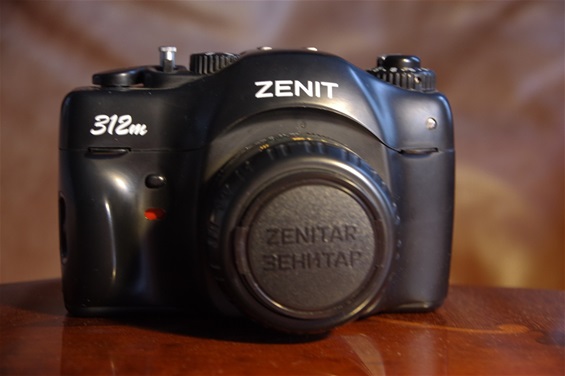 The 312 m of 1998 illustrates the last chapter of the Zenit story.
Bold design, but a very plastic feeling, even the very good Helios lens, renamed Zenitar, was plastic, and shutter times were still only 30 to 500. Size: 142x94x53 mm. Weight: 535 g. Sn. 00009508. Produced in year 2000.
The 312 m of 1998 illustrates the last chapter of the Zenit story.
Bold design, but a very plastic feeling, even the very good Helios lens, renamed Zenitar, was plastic, and shutter times were still only 30 to 500. Size: 142x94x53 mm. Weight: 535 g. Sn. 00009508. Produced in year 2000.
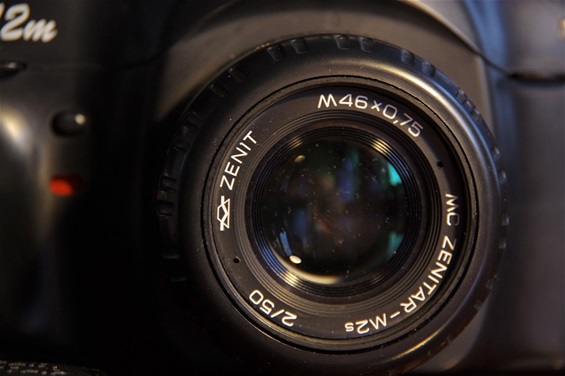 This is a very good 50/2 Helios lens, but renamed Zenitar and covered with plastic. Still M 42 mount!
Sn. 00016306.
This is a very good 50/2 Helios lens, but renamed Zenitar and covered with plastic. Still M 42 mount!
Sn. 00016306.
 ISO 600 as max, 30 to 500 shutter speed. All plastic except rewinder arm, flash shoe and shutter release button. A modern look was among the few things that had developed since the 50's.
While other brands were deep into digital picture machines..
This couldn't last. And it didn't. Zenit was history in 2005.
ISO 600 as max, 30 to 500 shutter speed. All plastic except rewinder arm, flash shoe and shutter release button. A modern look was among the few things that had developed since the 50's.
While other brands were deep into digital picture machines..
This couldn't last. And it didn't. Zenit was history in 2005.
|
|
 |
|
|
|